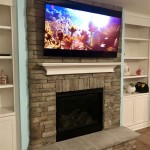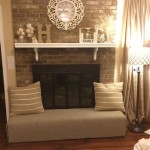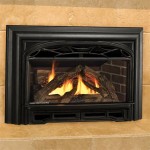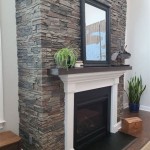How to Arrange Living Room Furniture With a Corner Fireplace and TV
Arranging furniture in a living room that features both a corner fireplace and a television can present a unique set of challenges. Both elements tend to demand focal point status, and successfully integrating them into a cohesive and functional design requires careful consideration of space, traffic flow, and viewing angles. This article will provide a comprehensive guide to effectively arranging furniture in a living room with a corner fireplace and TV, addressing common dilemmas and providing practical solutions.
The inherent awkwardness of a corner fireplace lies in its diagonal orientation. This configuration can disrupt the natural flow of a rectangular or square room, making it difficult to establish clear pathways and defined zones. The television, often a large, rectangular screen, usually requires a flat wall for optimal viewing. Combining these two elements effectively often necessitates creative compromises and strategic furniture placement.
Before moving any furniture, it's beneficial to take a detailed assessment of the living room. This includes measuring the dimensions of the room, noting the placement of windows and doors, and identifying any architectural features that might influence furniture placement. Consider the primary function of the room – is it mainly for watching television, entertaining guests, or a combination of both? Understanding the room's purpose and its physical limitations is the first step in creating a well-designed and functional space.
A critical aspect of planning involves establishing a scale floor plan. This can be created either manually with graph paper or digitally using readily available online tools or interior design software. The floor plan should accurately depict the dimensions of the room, the location of the fireplace, the proposed location of the television, and the size and shape of all furniture pieces. This visual representation allows for experimentation with different layouts without physically moving heavy objects. Different arrangements can be tested on paper, optimizing space and identifying potential problem areas before committing to a final design.
Prioritizing the Focal Point and Viewing Angle
One of the first decisions to make is determining which element will serve as the primary focal point. In some cases, the fireplace may be the more visually appealing feature, especially if it is a prominent architectural element. In other scenarios, the television may take precedence, particularly if the room is primarily used for entertainment. The choice between prioritizing the fireplace or the television will significantly impact how furniture is arranged.
If the fireplace is designated as the primary focal point, furniture should be arranged to draw attention to it. This can involve placing the main seating area, such as a sofa and armchairs, facing the fireplace. The television, in this case, would ideally be positioned to the side of the fireplace, perhaps on a credenza or media console. Angling the seating slightly toward the television can improve viewing angles without completely sacrificing the focus on the fireplace. This approach works best when the fireplace has unique features such as stonework or a decorative mantel.
Conversely, if the television is the primary focal point, furniture should be positioned to maximize viewing comfort. This typically involves placing the main seating directly facing the television. The fireplace, in this case, becomes a secondary element. Depending on the room’s layout, the television could be mounted above or to the side of the fireplace, although mounting directly above can strain the neck from constantly looking up. Careful attention must be paid to viewing distance to ensure optimal picture quality and minimize eye fatigue. The ideal viewing distance is typically calculated as 1.5 to 2.5 times the diagonal screen size of the television.
Addressing glare is also a crucial consideration when positioning the television. Natural light from windows can create distracting reflections on the screen, hindering the viewing experience. Therefore, it’s important to position the television away from direct sunlight or to use window treatments, such as blinds or curtains, to control the amount of light entering the room.
Addressing Furniture Placement and Traffic Flow
Once the focal point and viewing angles have been established, the next step is to consider the placement of furniture. The goal is to create a comfortable and functional space that facilitates conversation and allows for easy movement. The size and shape of the furniture should be proportional to the size of the room to avoid overcrowding or creating a sense of emptiness.
A common arrangement involves placing a sofa directly facing the focal point, whether it’s the fireplace or the television. Armchairs can be positioned on either side of the sofa, angled slightly inward to encourage conversation. A coffee table placed in the center of the seating area provides a convenient surface for drinks, snacks, and other items. The coffee table should be positioned at a comfortable distance from the sofa, allowing for easy access without obstructing legroom.
When dealing with a corner fireplace, it's often beneficial to use angled furniture to soften the sharp lines of the corner. A curved sofa or a set of armchairs with rounded backs can help to create a more inviting and visually appealing space. Additionally, consider using area rugs to define the seating area and anchor the furniture. The rug should be large enough to accommodate all of the front legs of the furniture, creating a sense of cohesion and visual unity.
Maintaining clear traffic flow is essential for creating a functional living room. Furniture should be arranged to allow for easy movement between different areas of the room without having to navigate around obstacles. Create pathways that are at least 30 inches wide to ensure comfortable passage. Avoid placing furniture directly in front of doorways or pathways, as this can create bottlenecks and make the room feel cramped.
In smaller living rooms, consider using multifunctional furniture to maximize space. A storage ottoman can serve as both a coffee table and a place to store blankets or other items. A sofa bed can provide additional sleeping space for guests without taking up extra floor space. Wall-mounted shelves can provide storage without cluttering the floor. Choosing furniture that serves multiple purposes can help to keep the room organized and visually uncluttered.
Incorporating Style and Functionality
Beyond furniture placement, the style and functionality of the room should also be considered. The color scheme, materials, and accessories can all contribute to the overall ambiance and appeal of the living room. Incorporating elements that reflect personal taste and style can help to create a space that is both comfortable and visually pleasing.
The fireplace itself can be enhanced with decorative accessories, such as candles, vases, or artwork. A decorative mantel can provide a focal point for displaying cherished items. Consider adding a mirror above the fireplace to reflect light and create a sense of spaciousness. The surrounding area can be further enhanced by adding shelving units or built-in cabinets to house media components, books, and other decorative items.
When choosing accessories, it's important to consider the overall style of the room. A modern living room might benefit from sleek, minimalist accessories, while a traditional living room might call for more ornate and decorative items. The color palette should be cohesive, with accessories complementing the furniture and walls. Soft furnishings, such as throw pillows and blankets, can add warmth and texture to the room, creating a cozy and inviting atmosphere.
Lighting plays a critical role in setting the mood and creating a comfortable ambiance. A combination of ambient, task, and accent lighting can help to illuminate the room and highlight its key features. Ambient lighting provides overall illumination, while task lighting provides focused light for reading or working. Accent lighting can be used to highlight artwork or architectural details.
Consider adding plants to the living room to bring a touch of nature indoors. Plants can help to purify the air and create a more relaxing and inviting atmosphere. Choose plants that are appropriate for the amount of light available in the room. Place plants strategically to fill empty spaces and add a pop of color to the room.
Finally, remember that the living room should be a reflection of personal style and taste. Don't be afraid to experiment with different arrangements and accessories until achieving a design that is both functional and visually appealing. The key is to create a space that is comfortable, inviting, and conducive to relaxation and enjoyment. By carefully considering furniture placement, traffic flow, and style, it is possible to create a living room that effectively integrates both a corner fireplace and a television into a cohesive and functional design.

Arranging Furniture With A Corner Fireplace Brooklyn Berry Designs

How To Arrange Furniture With A Corner Fireplace Setting For Four Interiors

How To Design Around A Corner Fireplace

How To Arrange Furniture With A Corner Fireplace Setting For Four Interiors

Home Staging Project Orange County Ca Decor

How To Arrange Furniture With A Corner Fireplace Living Room Modern Farmhouse Decor Arrangement

How To Arrange Furniture With A Corner Fireplace Setting For Four Interiors

How To Arrange Furniture In A Room With Corner Fireplace The Decorologist

How To Design Around A Corner Fireplace

Arranging Furniture With A Corner Fireplace Brooklyn Berry Designs








